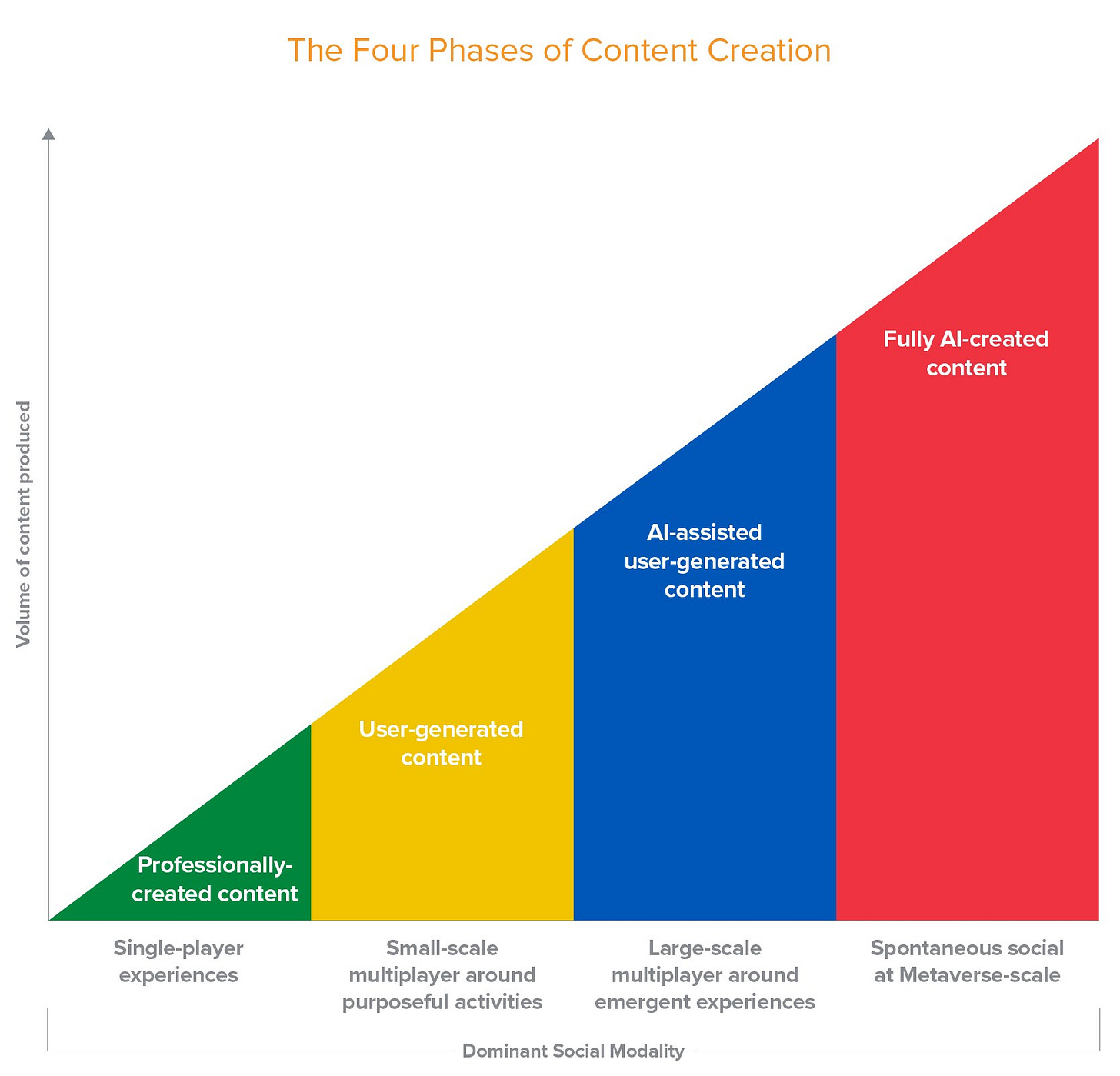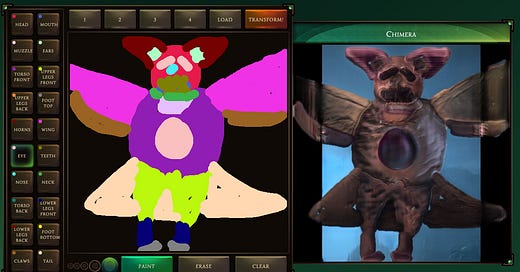Metamoments and verses, avatar audio, AI creations, SuperDubsmash, and Corntuth
December 18, 2020 Edition (#36)
Happy Holidays at long last, gang. This blessed edition (our 36th!) marks the conclusion of Trillium’s 2020 publishing schedule. We will be back and better than ever on January 8, 2021. Thanks for reading over the past 8+ months as we’ve gone from “respectably early-ish Substack user” to “complete and total cliché.” It was bound to happen at some point.

Metamoments: Substack Reader
Royal Reader RB, one of the innumerable Brooklynites in the Trilliuminati, texted me this week to ask whether he could “expect Trillium meta content about Substack Reader.” Though actively unpunctuated and notably ironic as befits Our Dear Reader, this message could only be answered in the affirmative.
Indeed, after many years of every tech leader or media personality referencing their undying love and affection for Google Reader in a foolproof attempt to curry favor with information-addicted audiences across the world, Substack’s CEO Chris Best recently mentioned the cherished RSS reader during a Decoder interview with The Verge’s Nilay Patel. [Ed.: I used Google Reader to organize all of my blog reading adventures and it was cool, but its departure from my life didn’t leave me feeling spiritually bereft].
Barely a week after Best’s interview on Decoder, Substack announced that it is launching a reader app (The Verge), appropriately named “Substack Reader.” The app streamlines all of your Substack subscriptions (#SubTrack?) and automatically updates each feed with new content. It is a relatively raw version of an RSS reader, at this point: clicking on any given article opens a new window with the content in question; there is, as yet, no in-line reading.
From Trillium’s perspective, there are two valuable dynamics at play. First, it’s exciting that readers could consume our content somewhere that isn’t their inbox. Many weeks, someone emails me to ask why I stopped writing Trillium, only for me to send a breathtakingly huffy reply asking them to check their Spam/Promotions folder. [Ed.: it’s always there]. I understand, though, because the same thing happens to me with many of the 39 (!) Substacks that I have, at some point in my quarantine hallucinations, signed up to read. Work-arounds like asking users to add the Trillium alias to their address book are effective, but cause too much friction for most readers and thus don’t really move the needle on the crucial “unintentional non-readers” metric. Given that 95%+ of Trillium’s readership comes through the inbox—the rest is "direct” or via Search—this is a key area for improvement.
Second, Substack now controls a consumer reading surface that they can use to recommend new content and to solve one of their most fundamental challenges: Discovery. As I mentioned in weeks past, it’s fine to abandon a mainstream media job to strike out on your own as a Substacktrepreneur [Ed.: not a thing], because you might well have tens or hundreds of thousands of followers on Twitter or other platforms. Converting those people to paying customers is not easy, but it is conceivable. For someone who does not have an existing audience, the likelihood of bootstrapping a new paid publication from scratch and getting meaningful readership is minimal, at best. This constraint, then, has downstream implications for the types of people that can operate a Substack.
I don’t know if Substack Reader will actually work as a means of driving new potential readers into the top of a writer’s conversion funnel, but at least it’s a potential mechanism to do so, and one that the company previously did not possess. I suspect Reader will also enable more fluid bundling of multiple publications. Here’s what the app’s Discover page looks like today:
If you’re interested in two longer-form pieces on Substack and its market implications, I recommend this Columbia Journalism Review piece by Clio Chang and this Nieman Lab piece by Michael Socolow. The latter discusses how Substack’s “toll gate” reinforces the value of paying for information and high-quality journalism, while acknowledging the risk of restricting access to elites who have the resources to purchase this content. The former focuses on the ways in which Substack both enables writer independence and reinforces the reach and standing of already established journalists: those who have the financial cushion or existing audience to make the leap into “the Substackerati.”
While the question of marginalization in media might seem unrelated to my comment around Substack’s need for a new discovery mechanism, I continue to feel that one of the most important things for Substack to do is offer audience-building tools to help fledgling or otherwise fringe writers build something from the ground up.
Chapter & (Meta)verse
A16Z’s Jonathan Lai wrote an article called, “Meet Me In The Metaverse” in which he talks about two trends supporting what he calls “fully emergent social experiences”: 1) the proliferation of user-generated content; 2) AI’s impact on generative content and character creation. It’s worth reading the piece, though the metaverse that Lai describes seems more incremental and akin to an evolved open-world videogame (perhaps experienced through VR) than the sort of full-fledged other world that some have envisioned. Crucially, others (like Matthew Ball) have defined the metaverse as including a fully functioning economy, as spanning physical and digital worlds, and as offering “interoperability” of items across the experiences contained within.
Lai’s piece doesn’t touch on some of these more exotic components, but it does a good job of providing case studies from existing virtual worlds, along with a survey of what’s going on in the user-generated content world today and where AI co-creation can play a role in the years to come.

My guess is that we’ll see much more of this metaverse content proliferating across the world of VC & tech Twitter over the months to come, as online game platform Roblox approaches its 2021 IPO. [Ed.: it’s worth noting that A16Z led Roblox’s $150M Series G earlier this year, so they have something of an (in)vested interest in this trend]. Roblox originally intended to go public in December 2020, but, seeing the Michael Buffer-esque hype energy currently at play in the tech IPO market—Airbnb & Doordash’s recent public offerings come to mind—chose to delay and recalibrate its pricing.
I’m personally bullish on Roblox and sympathetic to the long-term idea that it represents an evolution in the direction of the metaverse. I also think that the company’s core product is generally (mis)understood as a fantastically successful game, but not as a platform for an unlimited variety of different 3rd party creator and developer experiences. Roblox already functions as a platform that sustains other independent businesses: 2M developers are actively creating on the platform today; in 2019, Roblox devs made $110M on the platform.
The extensibility of that activity and revenue line is significant. Witness, if you can stomach it, the incredible success of 9-year-old YouTuber Ryan Kaji, whose “Ryan’s World” (and its $500M retail “empire”) is now coming to Roblox. (WSJ) Virtual goods from Ryan’s World can be purchased inside Roblox, of course. [Ed.: If you really want to feel terrible about your life, check out Ryan’s channel on YouTube. He has 27.5M subscribers and, lest you forget, he’s 9. What have you done this year?]
If AI can build it, they will come
One of the themes of Trillium in recent months has been the proliferation of content creation tools and the increasing role that AI plays in enabling what I’ll call “assisted amateur” or fully automated content creation. Given our focus on Roblox above, I’d be remiss not to mention that more than 21M players have used “AI music app Splash” (MusicAlly) inside Roblox, with 1M of those players trying the product in its first 20 days of existence.
Splash was created by Popgun, an Australian audio AI startup. It contains AI-created beats and loops and is intended to make it easy for anyone—even kids—to make professional-sounding music. Brilliantly, Popgun created a Roblox-appropriate version of the product so that it could use the game for distribution; you access Splash by visiting a virtual club, “Club Splash,” and DJing for yourself and others via Splash’s interface and audio building blocks.
I have to say: this is pretty much the best evolution of Childhood Me banging on my keyboard and trying to assess how many times I could hit the airhorn or “DEEEEJAAAAY” pad before someone yelled at me. And, in a further twist, Popgun is now working with “human” artists (MusicAlly) like Tones and I to create unique sound packs that players can access within Splash. In case you were keeping score, that makes it a 3rd party developer building a game within a game, and using 3rd party artists to augment their product’s source material. For more on this topic, check out Cherie Hu’s recent piece in DJMag, in which she argues that “games are tools for creativity in music, not just profit.”
The machine is learning
Halloween is in the past, but it’s never too late to write about “a surrealist, AI-assisted monster maker” produced by Google [Ed.: still our employer, though we didn’t have anything to do with this experiment]. (Input) Think: MS Paint on steroids, with an AI twist. Chimera Painter is an applet that enables users to draw shapes that are then “fully fleshed out by [Google’s] CreatureGAN machine learning model.” For more on what’s going on here, check out Devin Coldewey’s write-up in TechCrunch.
Essentially, the ML model powers the assistive element of the tool, meaning that technology will complete, augment, and improve whatever you might create. But, no worries, we humans are totally still in control of things. Check out my self-portrait below; I call it “Monday, 2020.” Yes, I put an eye in the center of my torso. I’ll see (👏) myself out.
If you prefer poetry to visual “art,” you might be more inclined to another Google AI experiment: Verse by Verse, an “experimental AI-powered muse that helps you compose poetry inspired by classic American poets.” I picked Frost, Dickinson, and Poe, naturally, and—manual curation notwithstanding—I’m pretty sure Trillium and our AI muse are destined to become the next Poet Laureate.

It’s easy to cast these tools as humorous novelties. And, right now, they often lack the breadth of functionality (and ease-of-use) to be much more. In our view, though, these sorts of AI creation experiments are harbingers of an exciting creative era to come: one in which human creativity, whether raw or refined, can be broadened and amplified by technology, and where amateurs can produce content of a quality that professionals alone can generate today.
SuperDubsmash
Two final news items. First: Facebook launched a new creator commerce feature (Input) via its “New Product Experimentation” program. The product is called Super, and it replicates Cameo-esque functionality that allows creators to livestream and consumers to reward them through digital tipping. Consumers can also pay to “appear alongside” the creator on the livestream, in a nod to Chinese livestream product mechanics. And, of course, creators can sell merch and other products through the Instagram Shop experience, and manage customer interactions through a unified back-office. Say what you will about Facebook’s net-new product ideas over the past few years, but they’re bringing things to market quickly and offering value to creators of all types.
Second: back in August, I wrote a deeply researched academic whitepaper in which I proclaimed the positive correlation between a startup’s “name eccentricity” (e.g., Crunchyroll) and financial valuation. My years of work on that piece were inspired, in part, by speculation that Facebook and Snap were considering acquiring Dubsmash (Reuters): a social video sharing app with which I was and remain blessedly unfamiliar. Well, turns out that Dubsmash was just acquired by Reddit for an undisclosed amount, in a somewhat strained attempt to add social video functionality to its primarily text-based platform. I am confident that putting short-form video creation tools into the hands of Restrained Redditors around the world is a totally risk-free proposition.
For your ears only
It’s the holiday season, so I’m going to abuse my curatorial powers for the sake of unrepentant nepotism. [Ed.: is there any other kind?] For 2020’s last “For your ears only,” I present Music to Work To, a great album despite the very significant megablunder in its title. The artist is none other than my brother, Fraternal Reader BNH; or, as New York Times writer Taylor Lorenz refers to him, “Brooklyn-based ambient producer Corntuth.” Indeed. [Ed.: we don’t know what a Corntuth is either].
The LP contains 13 improvisations done on BNH’s 1983 Yamaha synth and is excellent accompaniment for that airborne adventure that you’d normally be undertaking around the holidays, but are most definitely not this year. [Ed.: right?] It’s also the debut release on Flow State Records: the label arm of the Flow State music newsletter (two hours of music that’s perfect for working, sent out each weekday). Spin the record & subscribe to the newsletter.
See you all next year.
N





